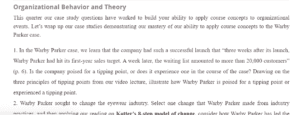Organizational Behavior and Theory
In the Warby Parker case, we learn that the company had such a successful launch that “three weeks after its launch, Warby Parker had hit its first-year sales target. A week later, the waiting list amounted to more than 20,000 customers” (p. 6). Is the company poised for a tipping point, or does it experience one in the course of the case? Drawing on the three principles of tipping points from our video lecture, illustrate how Warby Parker is poised for a tipping point or experienced a tipping point.
Warby Parker is poised for a tipping point thanks to its investment decisions geared towards higher future returns. The principles of tipping point come into play when a system is bombarded with forces of change (Havenga & Hobbs, 2004). At this point, there is a presumption for further growth, innovation, and the overall betterment of the income stream. To illustrate, Warby Parker made a consensus to halt taking orders since the long waiting time was almost costing the firm’s sales (Marquis & Villa, 2014). Instead, the management resorted to creating and incorporating a sold-out and waiting list functionality and suspending the try-on program. This move was timely as it took into account the possible losses associated with short-term contracts. Havenga and Hobbs (2004) demonstrate that in future contracts, prices are fixed in advance of commodities being supplied. At the same time are short-time in perspective, despite being some imperfect measures on offer. This situation is in line with the first principle of the tipping point, which posits that actual change, creativity, and true transformation are close to the tipping point (Havenga & Hobbs, 2004). The decisions to streamline the customer-order take are predicated on a reasonable guarantee of future returns on funds committed. Therefore, based on the innovative decision, it is reasonable to say that Warby Parker is poised for a tipping point.
Warby Parker sought to change the eyewear industry. Select one change that Warby Parker made from industry practices, and then applying our reading on Kotter’s 8-step model of change, consider how Warby Parker has led the change. How well do the company’s actions fit Kotter’s model of change? Would Kotter deem their approach successful?
One notable change that Warby Parker managed to initiate was managing the crisis. Notably, the firm recognized the importance of debuting with two giant fashion brands, GQ (men) and Vogue (women), while focusing on its business priorities. The change process broadly supports Kotter’s 8-step model of change, consisting of establishing a sense of urgency; creating the guiding coalition; developing a vision and strategy; communicating the change vision; empowering broad-based change; generating short-term wins; consolidating gains and producing more change; anchoring new approaches in the culture (Pollack & Pollack, 2014). These processes sufficiently guided Warby Parker‘s founders to make the change. The need to feature in the March issue of GQ created a sense of urgency, with the guiding coalition coming from the founders’ will to better the firm. After that, the company communicated its vision to other staff to stop taking further customer orders, communicating the change vision and empowering broad-based change. The first-year sales target demonstrates the short-term wins that the company had hit in the first three weeks. The following weeks spent apologizing to customers through phone conversations and e-mails marked the consolidation of gains and more changes in the company. Eventually, the anchoring of new approaches in the firm’s culture came into effect when the company managed all the distribution logistics with demo lenses and optical lab frame requirements. In this regard, Warby Parker would deem its approaches successful in maximizing the present value of its products’ net benefits.
Need help with your assignment ? Contact us at eminencepapers.com.
References
Havenga, J., & Hobbs, I. (2004). A practical guide to strategy: Making strategic thinking, development and implementation accessible. Jan Havenga & Ilse Hobbs.
Marquis, C., & Villa, L. (2014). Warby Parker: Vision of a “Good” Fashion Brand (pp. 1-24). Harvard Business School.
Pollack, J., & Pollack, R. (2014). Using Kotter’s Eight-Stage-Process to manage an organizational change program: Presentation and practice. Systemic Practice and Action Research, 28(1), 51-66. https://doi.org/10.1007/s11213-014-9317-0
ORDER A PLAGIARISM-FREE PAPER HERE
We’ll write everything from scratch
Question
Organizational Behavior and Theory
This quarter our case study questions have worked to build your ability to apply course concepts to organizational events. Let’s wrap up our case studies demonstrating our mastery of our ability to apply course concepts to the Warby Parker case.

Organizational Behavior and Theory
- In the Warby Parker case, we learn that the company had such a successful launch that “three weeks after its launch, Warby Parker had hit its first-year sales target. A week later, the waiting list amounted to more than 20,000 customers” (p. 6). Is the company poised for a tipping point, or does it experience one in the course of the case? Drawing on the three principles of tipping points from our video lecture, illustrate how Warby Parker is poised for a tipping point or experienced a tipping point.
- Warby Parker sought to change the eyewear industry. Select one change that Warby Parker made from industry practices, and then applying our reading on Kotter’s 8-step model of change, consider how Warby Parker has led the change. How well do the company’s actions fit Kotter’s model of change? Would Kotter deem their approach successful?
Notes:
- The tipping point lecture video is not available, check page 38 in the attached textbook for the three principles of tipping points (Tipping points and criticality)

